Coevolution of solid stress and interstitial fluid pressure in tumors during progression: implications for vascular collapse
- PMID: 23633490
- PMCID: PMC3702668
- DOI: 10.1158/0008-5472.CAN-12-4521
Coevolution of solid stress and interstitial fluid pressure in tumors during progression: implications for vascular collapse
Abstract
The stress harbored by the solid phase of tumors is known as solid stress. Solid stress can be either applied externally by the surrounding normal tissue or induced by the tumor itself due to its growth. Fluid pressure is the isotropic stress exerted by the fluid phase. We recently showed that growth-induced solid stress is on the order of 1.3 to 13.0 kPa (10-100 mmHg)--high enough to cause compression of fragile blood vessels, resulting in poor perfusion and hypoxia. However, the evolution of growth-induced stress with tumor progression and its effect on cancer cell proliferation in vivo is not understood. To this end, we developed a mathematical model for tumor growth that takes into account all three types of stresses: growth-induced stress, externally applied stress, and fluid pressure. First, we conducted in vivo experiments and found that growth-induced stress is related to tumor volume through a biexponential relationship. Then, we incorporated this information into our mathematical model and showed that due to the evolution of growth-induced stress, total solid stress levels are higher in the tumor interior and lower in the periphery. Elevated compressive solid stress in the interior of the tumor is sufficient to cause the collapse of blood vessels and results in a lower growth rate of cancer cells compared with the periphery, independently from that caused by the lack of nutrients due to vessel collapse. Furthermore, solid stress in the periphery of the tumor causes blood vessels in the surrounding normal tissue to deform to elliptical shapes. We present histologic sections of human cancers that show such vessel deformations. Finally, we found that fluid pressure increases with tumor growth due to increased vascular permeability and lymphatic impairment, and is governed by the microvascular pressure. Crucially, fluid pressure does not cause vessel compression of tumor vessels.
©2013 AACR.
Figures

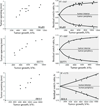

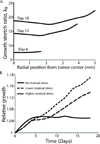
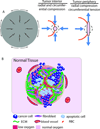
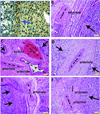
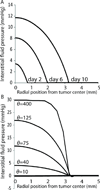
References
-
- Skalak R, Zargaryan S, Jain RK, Netti PA, Hoger A. Compatibility and the genesis of residual stress by volumetric growth. J Math Biol. 1996;34(8):889–914. - PubMed
-
- Helmlinger G, Netti PA, Lichtenbeld HC, Melder RJ, Jain RK. Solid stress inhibits the growth of multicellular tumor spheroids. Nat Biotechnol. 1997;15(8):778–783. - PubMed
Publication types
MeSH terms
Grants and funding
- R01 CA126642/CA/NCI NIH HHS/United States
- R01-CA085140/CA/NCI NIH HHS/United States
- R01-CA098706/CA/NCI NIH HHS/United States
- R01 CA098706/CA/NCI NIH HHS/United States
- R01 CA085140/CA/NCI NIH HHS/United States
- K12 CA090354/CA/NCI NIH HHS/United States
- P01-CA080124/CA/NCI NIH HHS/United States
- R24 CA085140/CA/NCI NIH HHS/United States
- R01-CA096915/CA/NCI NIH HHS/United States
- R01 CA115767/CA/NCI NIH HHS/United States
- R01 CA096915/CA/NCI NIH HHS/United States
- R01 CA163815/CA/NCI NIH HHS/United States
- R01-CA115767/CA/NCI NIH HHS/United States
- 2K12CA090354-11/CA/NCI NIH HHS/United States
- P01 CA080124/CA/NCI NIH HHS/United States
- R01-CA126642/CA/NCI NIH HHS/United States
LinkOut - more resources
Full Text Sources
Other Literature Sources

